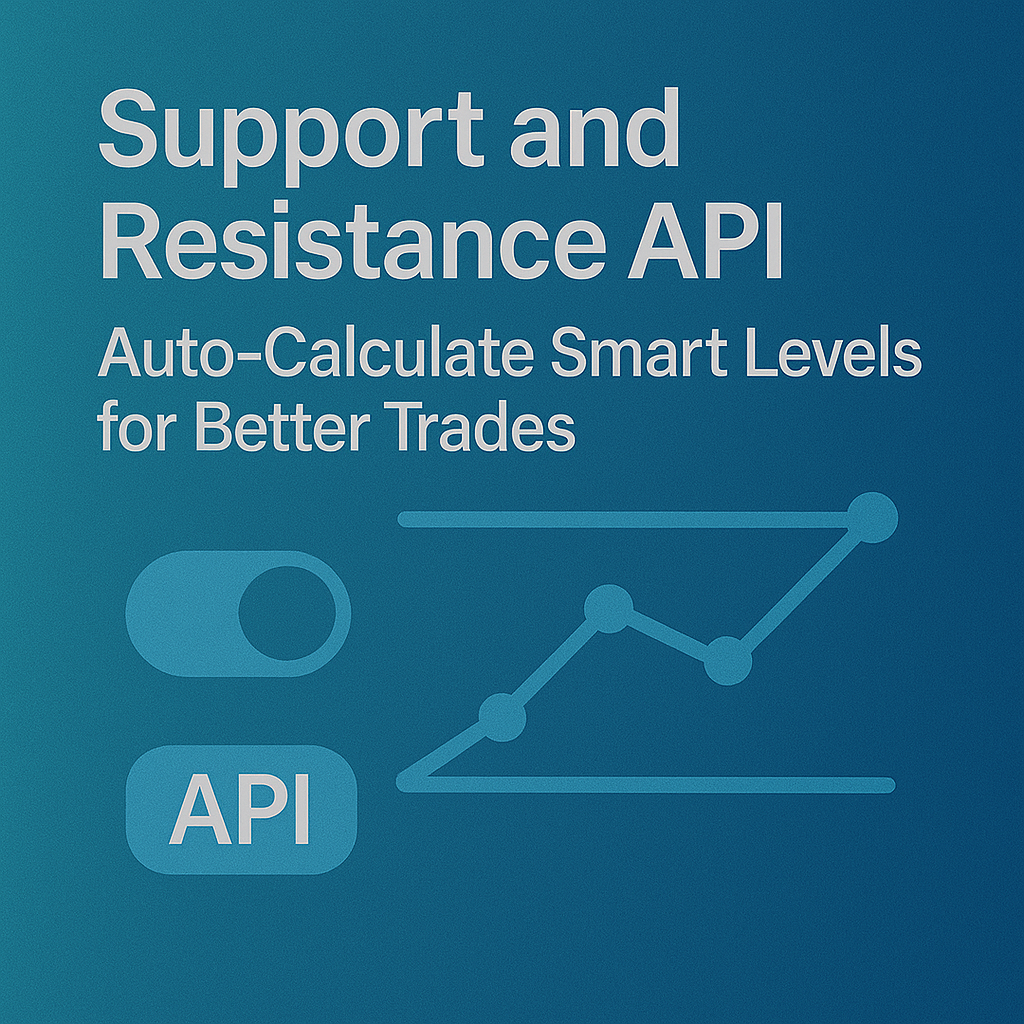Top Crypto Trading Platforms in 2025







%201.svg)
%201.svg)
Big news: We’re cranking up the heat on AI-driven crypto analytics with the launch of the Token Metrics API and our official SDK (Software Development Kit). This isn’t just an upgrade – it's a quantum leap, giving traders, hedge funds, developers, and institutions direct access to cutting-edge market intelligence, trading signals, and predictive analytics.
Crypto markets move fast, and having real-time, AI-powered insights can be the difference between catching the next big trend or getting left behind. Until now, traders and quants have been wrestling with scattered data, delayed reporting, and a lack of truly predictive analytics. Not anymore.
The Token Metrics API delivers 32+ high-performance endpoints packed with powerful AI-driven insights right into your lap, including:
Getting started with the Token Metrics API is simple:
At Token Metrics, we believe data should be decentralized, predictive, and actionable.
The Token Metrics API & SDK bring next-gen AI-powered crypto intelligence to anyone looking to trade smarter, build better, and stay ahead of the curve. With our official SDK, developers can plug these insights into their own trading bots, dashboards, and research tools – no need to reinvent the wheel.
%201.svg)
%201.svg)
The biggest gains in crypto rarely come from the majors. They come from Moonshots—fast-moving tokens with breakout potential. The Moonshots API surfaces these candidates programmatically so you can rank, alert, and act inside your product. In this guide, you’ll call /v2/moonshots, display a high-signal list with TM Grade and Bullish tags, and wire it into bots, dashboards, or screeners in minutes. Start by grabbing your key at Get API Key, then Run Hello-TM and Clone a Template to ship fast.
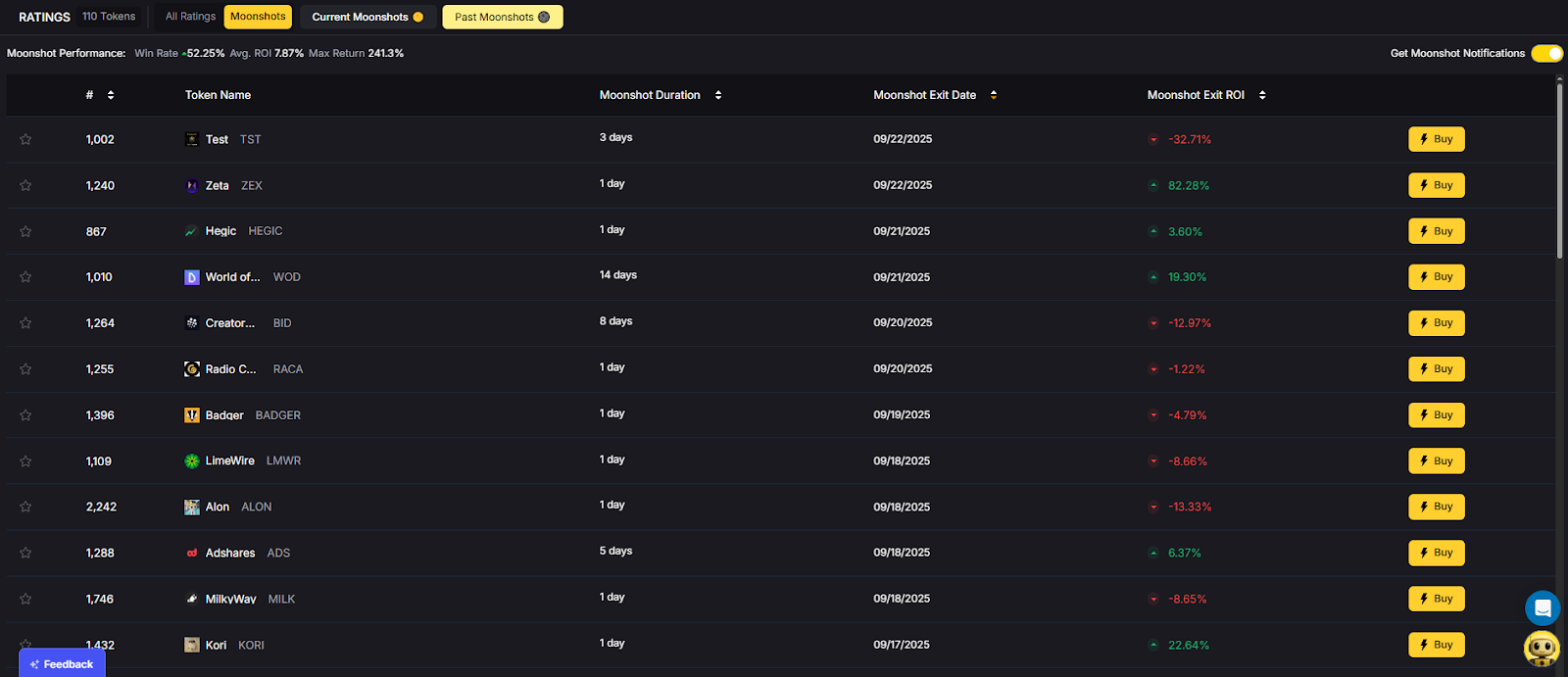
Discovery that converts. Users want more than price tickers—they want a curated, explainable list of high-potential tokens. The moonshots API encapsulates multiple signals into a short list designed for exploration, alerts, and watchlists you can monetize.
Built for builders. The endpoint returns a consistent schema with grade, signal, and context so you can immediately sort, badge, and trigger workflows. With predictable latency and clear filters, you can scale to dashboards, mobile apps, and headless bots without reinventing the discovery pipeline.
The Moonshots API cURL request is right there in the top right of the API Reference. Grab it and start tapping into the potential!
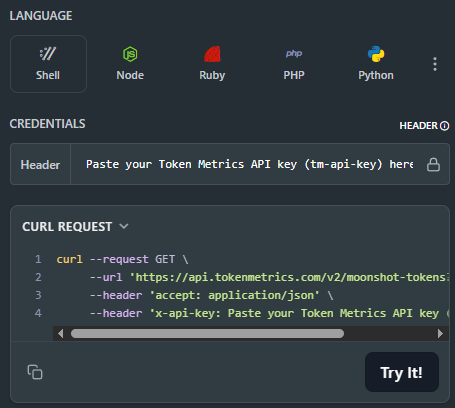
👉 Keep momentum: Get API Key • Run Hello-TM • Clone a Template
Fork a screener or alerting template, plug your key, and deploy. Validate your environment with Hello-TM. When you scale users or need higher limits, compare API plans.
The Moonshots endpoint aggregates a set of evidence—often combining TM Grade, signal state, and momentum/volume context—into a shortlist of breakout candidates. Each row includes a symbol, grade, signal, and timestamp, plus optional reason tags for transparency.
For UX, a common pattern is: headline list → token detail where you render TM Grade (quality), Trading Signals (timing), Support/Resistance (risk placement), Quantmetrics (risk-adjusted performance), and Price Prediction scenarios. This lets users understand why a token was flagged and how to act with risk controls.
Polling vs webhooks. Dashboards typically poll with short-TTL caching. Alerting flows use scheduled jobs or webhooks (where available) to smooth traffic and avoid duplicates. Always make notifications idempotent.
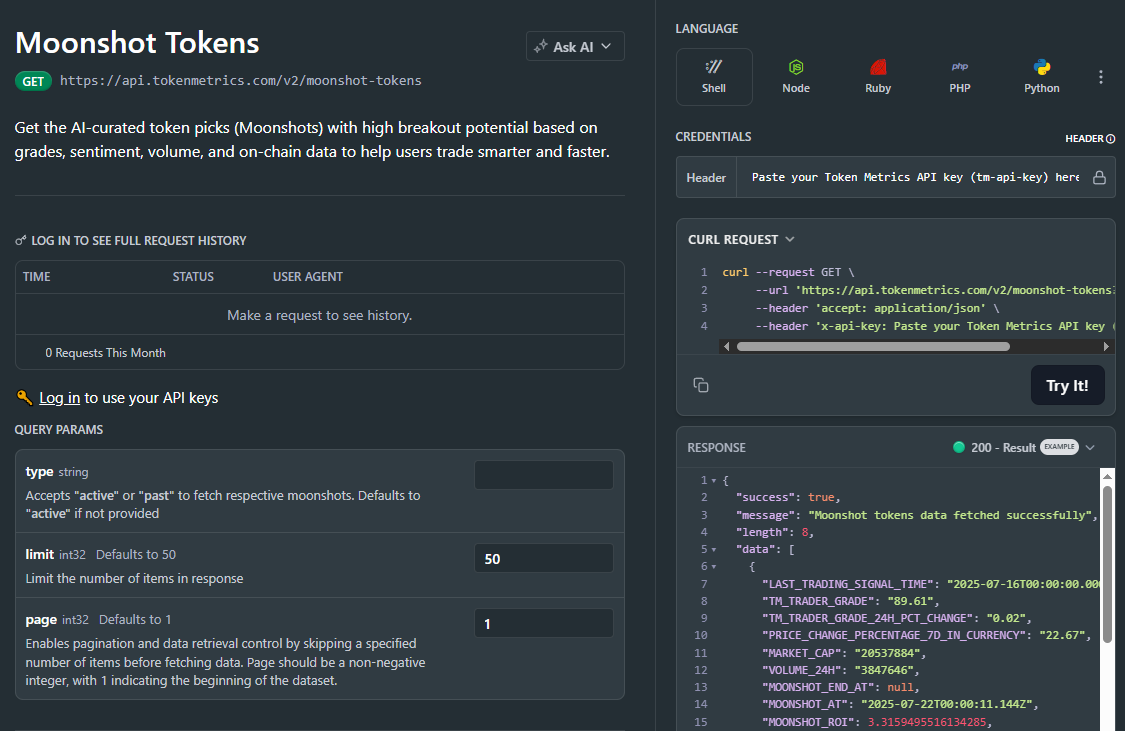
1) What does the Moonshots API return?
A list of breakout candidates with fields such as symbol, tm_grade, signal (often Bullish/Bearish), optional reason tags, and updated_at. Use it to drive discover tabs, alerts, and watchlists.
2) How fresh is the list? What about latency/SLOs?
The endpoint targets predictable latency and timely updates for dashboards and alerts. Use short-TTL caching and queued jobs/webhooks to avoid bursty polling.
3) How do I use Moonshots in a trading workflow?
Common stack: Moonshots for discovery, Trading Signals for timing, Support/Resistance for SL/TP, Quantmetrics for sizing, and Price Prediction for scenario context. Always backtest and paper-trade first.
4) I saw results like “+241%” and a “7.5% average return.” Are these guaranteed?
No. Any historical results are illustrative and not guarantees of future performance. Markets are risky; use risk management and testing.
5) Can I filter the Moonshots list?
Yes—pass parameters like min_grade, signal, and limit (as supported) to tailor to your audience and keep pages fast.
6) Do you provide SDKs or examples?
REST works with JavaScript and Python snippets above. Docs include quickstarts, Postman collections, and templates—start with Run Hello-TM.
7) Pricing, limits, and enterprise SLAs?
Begin free and scale up. See API plans for rate limits and enterprise options.
%201.svg)
%201.svg)
Most traders still draw lines by hand in TradingView. The support and resistance API from Token Metrics auto-calculates clean support and resistance levels from one request, so your dashboard, bot, or alerts can react instantly. In minutes, you’ll call /v2/resistance-support, render actionable levels for any token, and wire them into stops, targets, or notifications. Start by grabbing your key on Get API Key, then Run Hello-TM and Clone a Template to ship a production-ready feature fast.
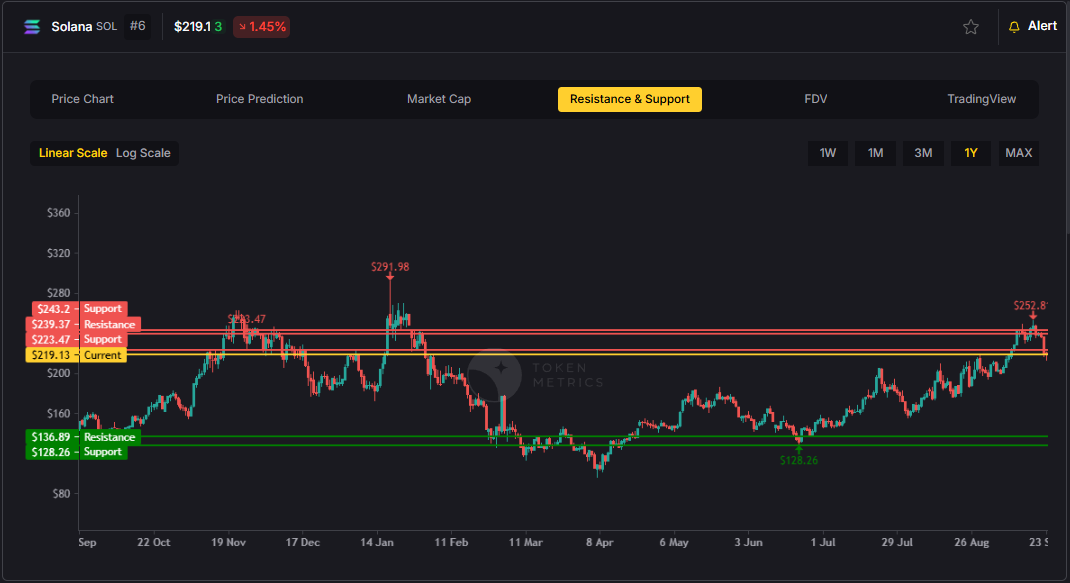
Precision beats guesswork. Hand-drawn lines are subjective and slow. The support and resistance API standardizes levels across assets and timeframes, enabling deterministic stops and take-profits your users (and bots) can trust.
Production-ready by design. A simple REST shape, predictable latency, and clear semantics let you add levels to token pages, automate SL/TP alerts, and build rule-based execution with minimal glue code.
Need the Support and Resistance data? The cURL request for it is in the top right of the API Reference for quick access.
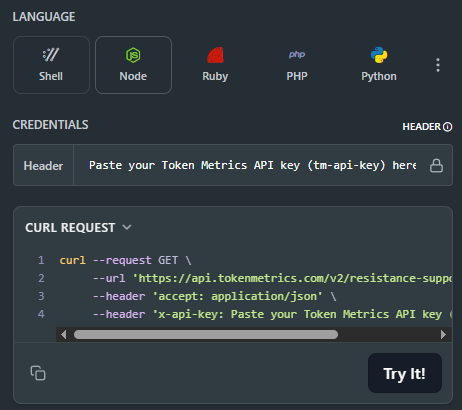
👉 Keep momentum: Get API Key • Run Hello-TM • Clone a Template
Kick off with our quickstarts—fork a bot or dashboard template, plug your key, and deploy. Confirm your environment by Running Hello-TM. When you’re scaling or need webhooks/limits, review API plans.
The Support/Resistance endpoint analyzes recent price structure to produce discrete levels above and below current price, along with strength indicators you can use for priority and styling. Query /v2/resistance-support?symbol=<ASSET>&timeframe=<HORIZON> to receive arrays of level objects and timestamps.
Polling vs webhooks. For dashboards, short-TTL caching and batched fetches keep pages snappy. For bots and alerts, use queued jobs or webhooks (where applicable) to avoid noisy, bursty polling—especially around market opens and major events.
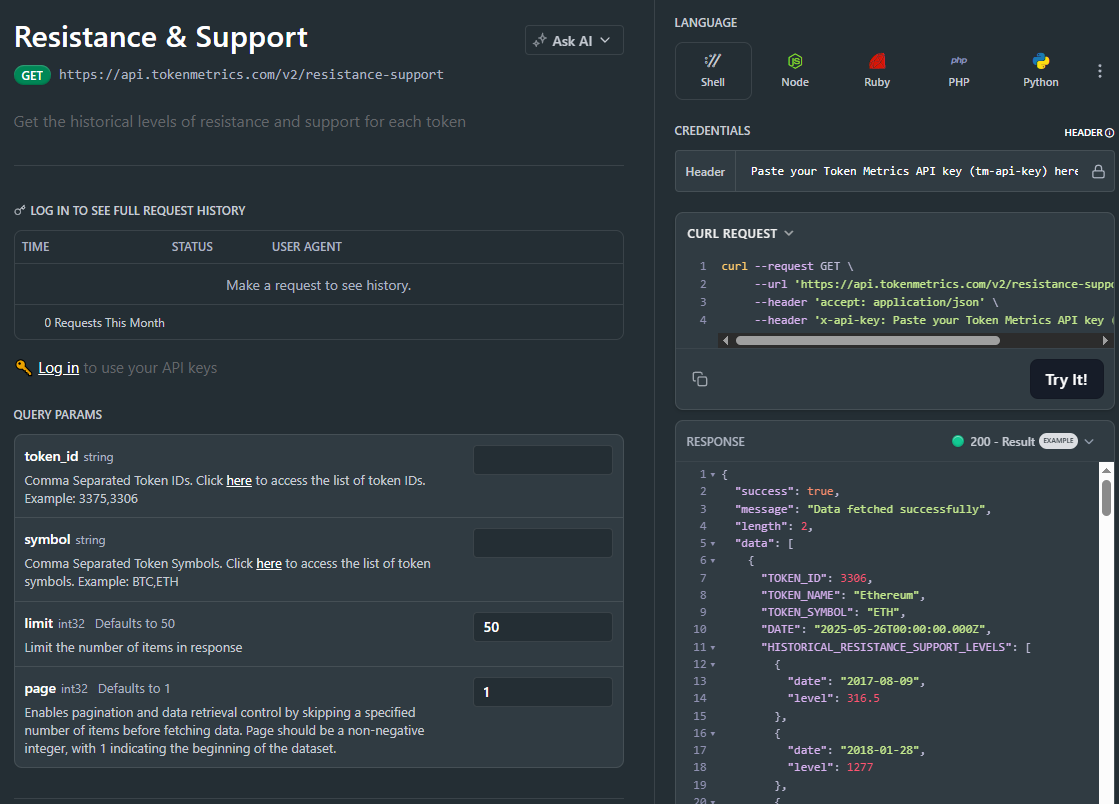
1) What does the Support & Resistance API return?
A JSON payload with arrays of support and resistance levels for a symbol (and optional timeframe), each with a price and strength indicator, plus an update timestamp.
2) How timely are the levels? What are the latency/SLOs?
The endpoint targets predictable latency suitable for dashboards and alerts. Use short-TTL caching for UIs, and queued jobs or webhooks for alerting to smooth traffic.
3) How do I trigger alerts or trades from levels?
Common patterns: alert when price is within X% of a level, touches a level, or breaks beyond with confirmation. Always make downstream actions idempotent and respect rate limits.
4) Can I combine levels with other endpoints?
Yes—pair with /v2/trading-signals for timing, /v2/tm-grade for quality context, and /v2/quantmetrics for risk sizing. This yields a complete decide-plan-execute loop.
5) Which timeframe should I use?
Intraday bots prefer shorter horizons; swing/position dashboards use daily or higher-timeframe levels. Offer a timeframe toggle and cache results per setting.
6) Do you provide SDKs or examples?
Use the REST snippets above (JS/Python). The docs include quickstarts, Postman collections, and templates—start with Run Hello-TM.
7) Pricing, limits, and enterprise SLAs?
Begin free and scale as you grow. See API plans for rate limits and enterprise SLA options.
%201.svg)
%201.svg)
Most traders see price—quants see probabilities. The Quantmetrics API turns raw performance into risk-adjusted stats like Sharpe, Sortino, volatility, drawdown, and CAGR so you can compare tokens objectively and build smarter bots and dashboards. In minutes, you’ll query /v2/quantmetrics, render a clear performance snapshot, and ship a feature that customers trust. Start by grabbing your key at Get API Key, Run Hello-TM to verify your first call, then Clone a Template to go live fast.
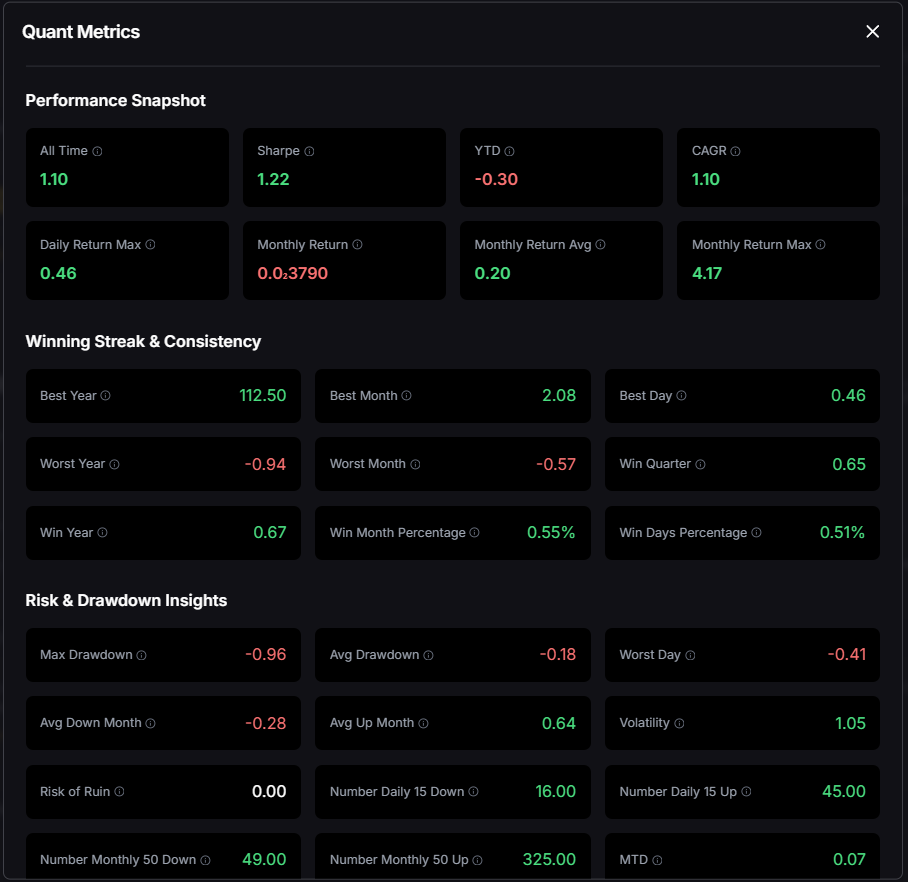
Risk-adjusted truth beats hype. Price alone hides tail risk and whipsaws. Quantmetrics compresses edge, risk, and consistency into metrics that travel across assets and timeframes—so you can rank universes, size positions, and communicate performance like a pro.
Built for dev speed. A clean REST schema, predictable latency, and easy auth mean you can plug Sharpe/Sortino into bots, dashboards, and screeners without maintaining your own analytics pipeline. Pair with caching and batching to serve fast pages at scale.
The Quant Metrics cURL request is located in the top right of the API Reference, allowing you to easily integrate it with your application.
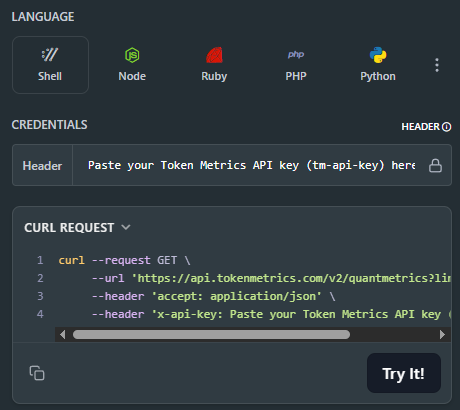
👉 Keep momentum: Get API Key • Run Hello-TM • Clone a Template
Kick off from quickstarts in the docs—fork a dashboard or screener template, plug your key, and deploy in minutes. Validate your environment with Run Hello-TM; when you need more throughput or webhooks, compare API plans.
Quantmetrics computes risk-adjusted performance over a chosen lookback (e.g., 30d, 90d, 1y). You’ll receive a JSON snapshot with core statistics:
Call /v2/quantmetrics?symbol=<ASSET>&window=<LOOKBACK> to fetch the current snapshot. For dashboards spanning many tokens, batch symbols and apply short-TTL caching. If you generate alerts (e.g., “Sharpe crossed 1.5”), run a scheduled job and queue notifications to avoid bursty polling.
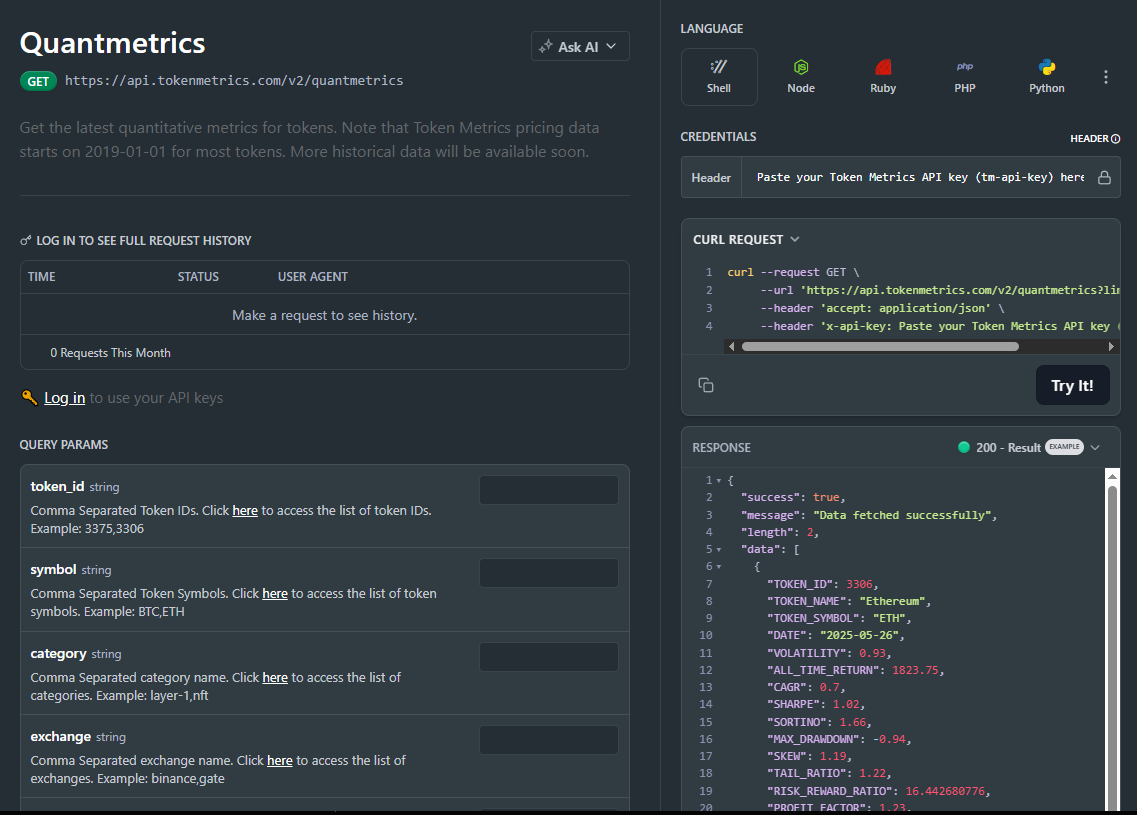
1) What does the Quantmetrics API return?
A JSON snapshot of risk-adjusted metrics (e.g., Sharpe, Sortino, volatility, max drawdown, CAGR) for a symbol and lookback window—ideal for ranking, sizing, and dashboards.
2) How fresh are the stats? What about latency/SLOs?
Responses are engineered for predictable latency. For heavy UI usage, add short-TTL caching and batch requests; for alerts, use scheduled jobs or webhooks where available.
3) Can I use Quantmetrics to size positions in a live bot?
Yes—many quants size inversely to volatility or require Sharpe ≥ X to trade. Always backtest and paper-trade before going live; past results are illustrative, not guarantees.
4) Which lookback window should I choose?
Short windows (30–90d) adapt faster but are noisier; longer windows (6–12m) are steadier but slower to react. Offer users a toggle and cache each window.
5) Do you provide SDKs or examples?
REST is straightforward (JS/Python above). Docs include quickstarts, Postman collections, and templates—start with Run Hello-TM.
6) Polling vs webhooks for quant alerts?
Dashboards usually use cached polling. For threshold alerts (e.g., Sharpe crosses 1.0), run scheduled jobs and queue notifications to keep usage smooth and idempotent.
7) Pricing, limits, and enterprise SLAs?
Begin free and scale up. See API plans for rate limits and enterprise SLA options.
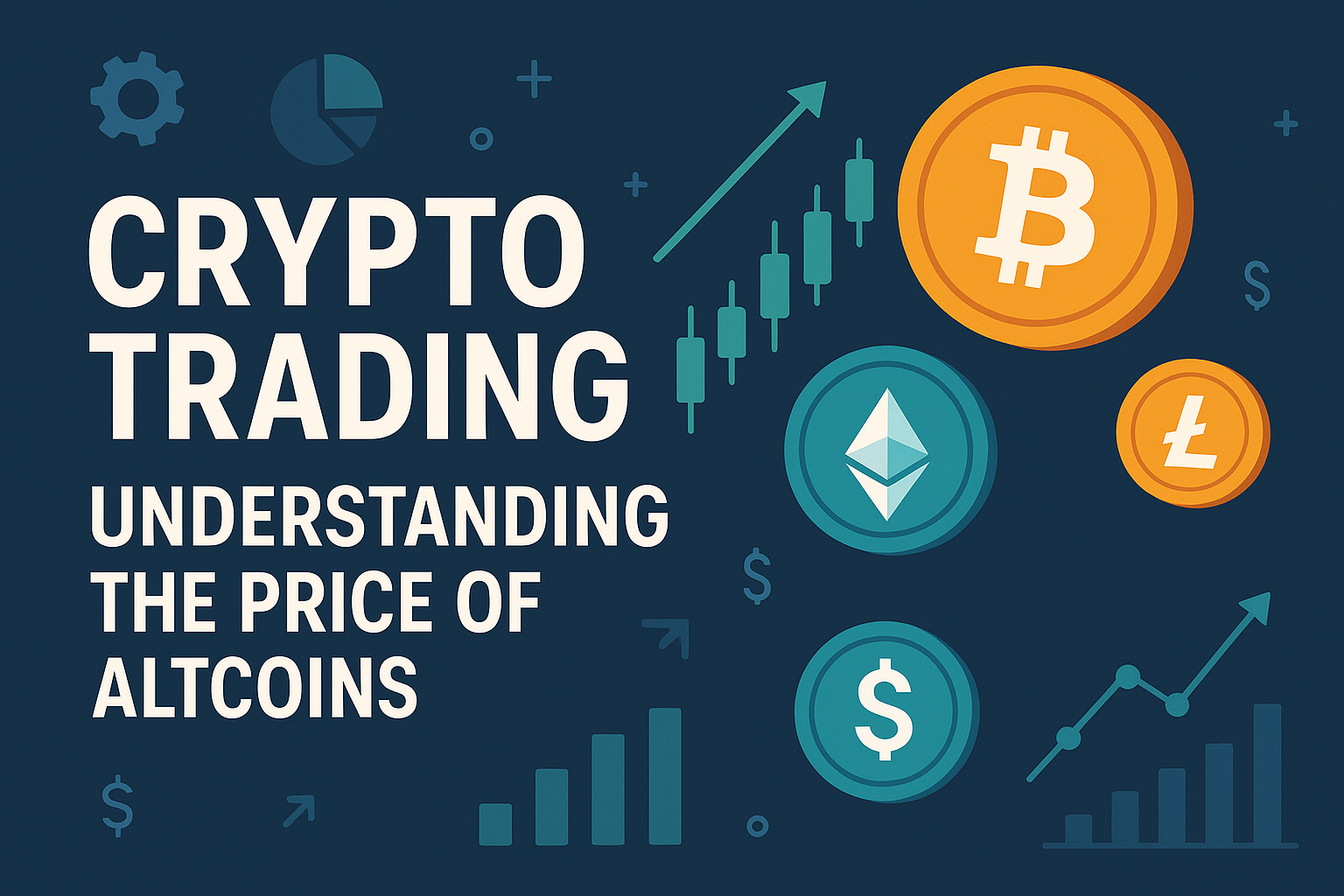
%201.svg)
%201.svg)
In the dynamic world of crypto trading, understanding the price of altcoins is crucial for anyone looking to trade cryptocurrency effectively. Altcoins, or alternative cryptocurrencies to Bitcoin, play a significant role in the cryptocurrency market, offering diverse opportunities for traders and investors. Cryptocurrency is a digital or virtual currency that operates on distributed ledger technology called a blockchain and uses cryptography for security. This article will explore the factors influencing altcoin prices, how traders can predict price movements, and the strategies to trade crypto assets successfully on various crypto platforms.

The price of altcoins is influenced by multiple factors that interact within the broader cryptocurrency market. Unlike traditional currencies issued by a central bank, altcoins operate on decentralized blockchain technology, which adds a unique layer of complexity to their value changes. One of the primary drivers of altcoin prices is market trends, which reflect the overall sentiment and behavior of traders in the crypto market.
Cryptocurrency trading is notoriously volatile, meaning price trends can shift rapidly due to news, regulatory changes, technological developments, or shifts in market conditions. For example, the launch of new features on a blockchain network or advancements in cryptocurrency mining can create opportunities arise for altcoins to gain value. Additionally, the liquidity of an altcoin on cryptocurrency exchanges affects its price; altcoins with high liquidity tend to have more stable price movements compared to those with low liquidity.

Another critical factor is the comparison to traditional markets and fiat currency values such as the US dollar. Since altcoins are often traded against fiat currencies or major cryptocurrencies like bitcoin and bitcoin cash, fluctuations in these values can directly impact altcoin prices. Traders also need to consider the impact of supply and demand dynamics within the crypto exchange platforms where these digital assets are bought and sold.
To trade crypto effectively, it is essential to predict price movements accurately. Day traders and other market participants use various methods to recognize patterns and forecast price trends. Technical analysis is one of the most widely used tools, involving the study of historical price data, chart patterns, and indicators to identify optimal entry and exit points in the market.

By analyzing price trends and market conditions, traders can place limit orders on a crypto exchange to buy or sell altcoins at desired prices, helping manage risk and maximize profits. Effective risk management strategies are necessary to mitigate potential losses in trading. A good understanding of how value changes in digital currency markets occur can help traders develop strategies that align with their risk tolerance and investment goals.
Unlike traditional currencies, the crypto market operates 24/7, providing continuous opportunities for trading. This round-the-clock nature, combined with the high volatility of altcoins, means that traders must stay vigilant and informed to capitalize on favorable price movements.
Successfully trading altcoins requires a combination of knowledge, strategy, and the right tools. First and foremost, traders need to select a reliable crypto platform or cryptocurrency exchange that offers low fees, high liquidity, and robust security measures to protect their crypto account and digital assets. Trusted platforms like Gemini, Binance, and Coinbase adhere to local and international laws, providing secure and legal trading environments.

Day trading is a popular approach in the crypto market, where traders buy and sell altcoins within short time frames to capitalize on price volatility. Day trading is the business of trading assets within the same day to gain small profits from temporary price fluctuations. This strategy demands a high risk tolerance and the ability to quickly analyze market trends and execute trades efficiently.
For those new to cryptocurrency trading, it is advisable to dive deeper into understanding the fundamentals of blockchain technology and how different altcoins function within their respective blockchain networks. Successful traders often invest in their education and practice to refine their strategies and skills. This knowledge can provide insights into the potential long-term value of various crypto assets.
Moreover, traders should diversify their portfolios by including multiple altcoins alongside well-established cryptocurrencies like bitcoin. This diversification helps mitigate risk and take advantage of different market opportunities.
The price of altcoins in the cryptocurrency market is influenced by a complex interplay of factors ranging from market trends and liquidity to technological developments and regulatory environments. To trade crypto successfully, it is essential to develop a good understanding of these elements, utilize technical analysis to predict price movements, and adopt strategies that suit individual risk tolerance and market conditions.
Whether you are looking to buy cryptocurrencies for the first time or are an experienced trader aiming to optimize your crypto journey, staying informed and choosing the right crypto platform can significantly enhance your ability to earn rewards and profits in this notoriously volatile market. By recognizing patterns, managing risk, and leveraging the unique features of digital currencies, traders can navigate the exciting world of altcoin trading with confidence and success.

%201.svg)
%201.svg)
Understanding what is peer to peer crypto exchange is essential for anyone interested in trading digital assets in today’s evolving cryptocurrency market. A peer to peer (P2P) crypto exchange is a platform that enables users to trade cryptocurrencies directly with one another without the involvement of a central authority. Unlike centralized exchanges, which act as intermediaries and control the flow of transactions, P2P crypto exchanges facilitate decentralized trading, creating a secure and transparent environment for crypto trading.
This decentralized nature offers several advantages, including lower trading fees and greater control over transactions. P2P crypto exchanges are rapidly gaining popularity among users seeking a more cost-effective and convenient way to trade digital assets. By eliminating the middleman, these platforms foster a global marketplace where buyers and sellers can connect directly, making crypto trading more accessible and efficient.
P2P crypto trading operates by connecting buyers and sellers directly through a trading platform that acts as a facilitator rather than a controller. Users on these platforms can create personalized trading offers, specifying the amount of cryptocurrency they wish to buy or sell and the transaction terms. One of the key features of P2P trading is the flexibility in choosing payment options. Traders can select from diverse payment methods, including bank transfers, cash payments, and other convenient payment methods, depending on what suits them best.
To ensure secure and transparent transactions, P2P crypto exchanges rely heavily on escrow services. When a trade is initiated, the cryptocurrency is held in escrow by the platform until both parties confirm the transaction terms have been met. This mechanism protects users from fraud and guarantees that the digital assets are only released when the agreed conditions are fulfilled. The entire network supporting P2P crypto trading is built on blockchain technology, which validates transactions and maintains a secure ledger, ensuring fast and secure transactions across the global market.
Decentralized trading through P2P crypto exchanges offers multiple benefits that appeal to users looking for more control and cost savings. One of the most significant advantages is the lower trading fees compared to traditional exchanges. Since P2P platforms do not rely on a central authority to manage trades, they can operate with reduced overhead costs and pass those savings on to users.
Moreover, P2P crypto exchanges provide a secure and transparent way to trade digital assets, reducing the risk of scams that can be prevalent in other trading environments. Users enjoy more autonomy, negotiating directly with their trading partners and creating personalized trading offers tailored to their needs. This level of customization is not typically available on centralized exchanges.
The rise of decentralized finance (DeFi) has further propelled the popularity of P2P crypto exchanges. By enabling peer-to-peer transactions without intermediaries, these platforms embody the core principles of DeFi, empowering users to manage their crypto assets securely and independently.
When comparing P2P crypto exchanges to traditional exchanges, several key differences stand out. Unlike traditional exchanges that often charge significant trading fees, many P2P crypto exchanges either charge minimal fees or none at all, making them a more attractive option for traders looking to maximize their returns.
Security and privacy are other critical areas where P2P platforms excel. Traditional exchanges typically require users to provide extensive personal information to comply with regulatory requirements, which can be a barrier for privacy-conscious users. In contrast, P2P crypto exchanges offer a more private and secure way to trade, often requiring less personal data while still maintaining regulatory compliance.
Additionally, P2P crypto exchanges are designed to be user-friendly and convenient, allowing users to trade digital assets directly with their chosen trading partners. This direct interaction often results in more flexible exchange rates and payment options, enhancing the overall trading experience compared to the more rigid structures of traditional exchanges.
Security is paramount in the world of cryptocurrency transactions, and P2P crypto exchanges implement robust security measures to protect users. Two-factor authentication (2FA) is commonly used to add an extra layer of account security, preventing unauthorized access. Escrow services play a vital role in securing transactions by holding funds until both parties confirm the trade’s completion.
Smart contracts are increasingly integrated into P2P platforms to automate and enforce transaction terms securely and transparently. These self-executing contracts reduce the risk of disputes and fraud by ensuring that trades occur only when predefined conditions are met.
In the event of disagreements, reputable P2P crypto exchanges have a dispute resolution system in place to provide fair and efficient conflict management. Additionally, some platforms utilize distributed hash tables within their network structure to enhance transaction security and transparency, ensuring that all trades rely on validated and trustworthy processes.
One of the defining features of P2P crypto exchanges is their support for diverse payment methods, catering to users worldwide. Traders can select the most convenient payment method for their needs, whether that’s bank transfers, cash payments, or other secure payment methods. This flexibility allows for seamless trading of digital assets across different regions and currencies.
P2P platforms often support multiple fiat currencies, broadening the accessibility of crypto trading to a global audience. The use of escrow services further ensures that payments are secure and transparent, minimizing the risk of fraud during transactions. By accommodating a wide array of payment options, P2P crypto exchanges make it easier for users to engage in crypto trading regardless of their preferred financial systems.
Despite their decentralized nature, P2P crypto exchanges must adhere to regulatory compliance standards to maintain legitimacy and trust. This includes enforcing anti-money laundering (AML) and know-your-customer (KYC) regulations to verify that all users are legitimate traders and to reduce fraudulent activities.
Reputable platforms implement strict security protocols such as two-factor authentication and escrow services to protect users and comply with legal requirements. Regulatory compliance is essential not only for protecting users but also for fostering a secure trading environment that encourages wider adoption of P2P crypto trading in the global market.
P2P crypto exchanges play a pivotal role in the broader crypto market by offering a secure, transparent, and cost-effective alternative to traditional trading platforms. Their decentralized networks allow users to trade digital assets directly, cutting down on intermediaries and associated fees.
The integration of blockchain technology and smart contracts ensures that transactions are validated and secure, providing users with confidence in their trades. As a result, P2P crypto exchanges are becoming increasingly popular, especially among users seeking lower costs and more control over their crypto assets. Their influence in the global marketplace is expected to grow, further shaping the future of cryptocurrency exchange.
P2P networks can be categorized into different types based on their structure and functionality. Structured networks utilize distributed hash tables to organize and locate resources efficiently, ensuring secure and transparent transactions within the network. This structure is particularly beneficial for P2P crypto exchanges as it enhances the reliability and security of the trading platform.
Unstructured networks, on the other hand, are more flexible and less organized, often used for applications like file sharing and communication. While they offer adaptability, they may lack the robustness required for secure crypto trading.
Hybrid networks combine elements of both structured and unstructured networks, offering a balance between security, flexibility, and efficiency. This hybrid approach allows P2P crypto exchanges to leverage the benefits of both network types, creating a more secure and user-friendly trading environment for digital assets.
In summary, understanding what is peer to peer crypto exchange reveals a powerful and evolving method for trading digital assets. By enabling direct trades between parties without a central authority, P2P crypto exchanges provide a secure, transparent, and cost-effective alternative to traditional exchanges. With robust security measures, diverse payment options, and regulatory compliance, these platforms are well-positioned to play a significant role in the future of cryptocurrency trading. Whether you are a beginner or an experienced trader, exploring P2P crypto trading offers exciting opportunities in the dynamic crypto market.

%201.svg)
%201.svg)
Selling large amounts of crypto requires careful planning, a solid understanding of the market, and knowledge of the different trading methods available. Whether you want to sell bitcoin or other digital assets, it’s important to consider factors such as the current market price, tax implications, and security measures to ensure a smooth and profitable transaction. In this article, we will explore how to sell large amounts of crypto effectively, covering everything from centralized exchanges to peer-to-peer platforms and over-the-counter (OTC) trading.
When it comes to how to sell large amounts of crypto, understanding the market landscape is the first step. There are several trading methods to choose from, including centralized exchanges, peer-to-peer platforms, and OTC trading desks. Each option offers unique advantages and challenges, so selecting the right approach depends on your specific needs and the amount of bitcoin or other crypto assets you intend to sell.
Tax implications also play a crucial role in crypto sales. Selling digital assets like Bitcoin often triggers a taxable event, subject to capital gains tax. Knowing how these taxes apply in your jurisdiction and maintaining accurate transaction records can help you stay compliant and avoid unexpected liabilities.
Another key consideration is the current market price and price fluctuations. Since cryptocurrencies are volatile assets, large transactions can impact the market price, leading to price slippage and unfavorable rates. Therefore, minimizing market impact by using strategic selling methods is essential to maximize returns.
Finally, opting for a user-friendly platform with low trading fees and robust security measures ensures a straightforward process. Features like two-factor authentication and withdrawal limits help protect your holdings while providing flexibility in managing large transactions.
Centralized exchanges are a popular choice for selling bitcoin due to their convenience and liquidity. Platforms like Token Metrics, Binance and Coinbase allow users to sell crypto quickly, but they often come with high transaction fees and withdrawal limits that can affect large transactions. Additionally, these exchanges have a verification process and security protocols such as two-factor authentication to safeguard user accounts.

Peer-to-peer trade platforms offer an alternative by enabling you to sell bitcoin directly to other users. This method often involves lower fees and more flexible payment methods, including bank transfers and cash. Peer-to-peer platforms facilitate trade directly between parties, reducing the market impact and providing a more personalized service. However, they require caution to avoid security risks when dealing with other users.
For substantial amounts of bitcoin, OTC trading desks are particularly suitable. OTC services allow buyers and sellers to conduct large transactions privately, avoiding the price fluctuations and market impact associated with regular exchange orders. OTC desks offer personalized service and often have lower withdrawal fees and transaction costs compared to major exchanges. Using OTC trading can help you sell crypto safely and efficiently without affecting the overall market price.
Another option is using crypto debit cards, which allow you to convert bitcoin to fiat currency and spend it directly. While convenient, these cards may have high fees and limited withdrawal options, making them less ideal for very large sums.
When selecting where to sell crypto, major exchanges and crypto trading platforms like Token Metrics, Binance, Coinbase, and Kraken stand out due to their extensive payment methods and strong security measures. These platforms support bank transfers, credit cards, and sometimes even crypto debit cards, providing flexibility in how you receive funds.
Security is paramount on centralized exchanges. Reputable exchanges implement rigorous security measures, including cold storage for digital currencies, regular security audits, and mandatory two-factor authentication. Enabling two-factor authentication on your exchange account is essential to prevent unauthorized access and protect your crypto holdings.
Some major exchanges offer personalized services tailored for large transactions. These services can help minimize market impact by facilitating limit orders or OTC transactions through their internal desks. Choosing an exchange with low trading fees and withdrawal fees can significantly improve your net proceeds when selling large amounts of crypto.
Bitcoin ATMs provide a quick and convenient way to sell bitcoin directly for cash. Using a bitcoin ATM, you can send bitcoin to a deposit address or scan a QR code to complete the transaction within a few hours. However, bitcoin ATMs often charge high fees and have limited withdrawal limits, making them less suitable for selling large sums.
Peer-to-peer platforms like LocalBitcoins or Paxful allow you to sell bitcoin directly to other users. These platforms offer a variety of payment methods and typically have lower fees than centralized exchanges. Peer-to-peer trade can be a straightforward process, but it requires vigilance to avoid scams or security risks when dealing with other users.
OTC trading services are the preferred choice for handling large transactions. OTC desks provide a personalized experience, allowing you to negotiate a specific price and avoid price slippage. These services are designed to handle amounts of bitcoin that would otherwise disrupt the market if sold on regular exchanges.
Additionally, some crypto exchange services such as TransFi’s Ramp offer comprehensive solutions for selling large amounts of bitcoin. They combine the benefits of OTC trading with streamlined payment and withdrawal options, making it easier to convert bitcoin to fiat currency securely and efficiently.
Choosing the right payment and withdrawal methods is crucial when selling large amounts of crypto. Bank transfers are commonly used for receiving fiat currency after selling bitcoin. While bank transfers are generally secure, they can involve high fees and may take several days to process, which could delay access to your funds.
Crypto debit cards provide an alternative by allowing you to withdraw cash or make purchases directly using your crypto balance. However, these cards often come with high fees and are not accepted everywhere, which limits their usefulness for large transactions.
Peer-to-peer platforms usually support a wide range of payment methods, including cash deposits, bank transfers, and online payment services. Selecting a payment method with low fees and fast processing times helps optimize your sale and reduces the risk of delays.
When using centralized exchanges, be mindful of withdrawal limits and withdrawal fees. Some exchanges impose daily or monthly limits that could restrict how much fiat currency you can access at once. Understanding these limits ahead of time ensures you can plan your sales accordingly.

Security is a top priority when selling large amounts of bitcoin or other crypto assets. Enabling two-factor authentication on your exchange account and wallets is essential to protect against unauthorized access. This added layer of security helps safeguard your digital assets from hacking attempts.
Reputable exchanges and platforms implement advanced security measures such as cold storage, where the majority of funds are kept offline, and regular security audits to identify vulnerabilities. Using these platforms reduces the risk of losing your crypto due to security breaches.
In addition to platform security, using a secure wallet to store your bitcoin before and after the sale is critical. Hardware wallets or trusted software wallets with strong encryption provide the best protection.
Regularly monitoring your account activity and being aware of potential security risks, such as phishing attacks or suspicious transactions, can help you respond quickly to threats and prevent losses.
Understanding the tax implications of selling digital assets is vital. In many jurisdictions, selling bitcoin constitutes a taxable event subject to capital gains tax. The amount of tax owed depends on factors like how much bitcoin you sold, the holding period, and your local tax laws.
Tax regulations for cryptocurrencies vary significantly between countries, so it’s important to familiarize yourself with the rules that apply to you. Keeping detailed records of your transactions, including dates, amounts, and prices, will make tax reporting easier and more accurate.
Some countries have specific regulations governing cryptocurrency exchanges and OTC transactions. Compliance with these laws ensures your sales are legitimate and reduces the risk of legal issues.
Consulting a tax professional experienced in digital currencies can provide guidance tailored to your situation, helping you navigate complex tax laws and optimize your tax liabilities.
Many sellers face challenges when handling large crypto transactions. One common mistake is not understanding the tax implications, which can lead to unexpected capital gains tax bills and financial losses.
Failing to use two-factor authentication leaves accounts vulnerable to hacking and unauthorized access, risking the loss of your crypto holdings.
Choosing an unreliable or unregulated exchange can result in high fees, poor customer service, and even security breaches. Always select reputable exchanges with a solid track record.
Neglecting to monitor your account activity regularly increases the risk of unnoticed fraudulent transactions or security breaches. Staying vigilant helps protect your assets.
The cryptocurrency market is highly volatile and subject to rapid changes. Staying informed about market trends and price fluctuations enables you to time your sales effectively, minimizing market impact and maximizing profit.

Regulations and tax laws surrounding crypto are continually evolving. Keeping up-to-date with these changes ensures you remain compliant and avoid legal complications.
Regularly reviewing and enhancing your security measures, such as updating passwords and enabling new security features, helps protect your accounts from emerging threats.
Adapting your trading strategies in response to market conditions and regulatory changes is key to successful crypto sales over time.

To sell large amounts of crypto successfully, choose a reputable exchange or platform that offers low fees, strong security measures, and flexible payment options. Understanding the tax implications and maintaining accurate transaction records will keep you compliant and prepared for tax season.
Always enable two-factor authentication and use secure wallets to safeguard your crypto assets. Regularly monitor your accounts for suspicious activity to prevent losses.
Finally, stay informed about market trends, regulatory updates, and security best practices. By adapting your approach to changes in the crypto landscape, you can maximize profits, minimize risks, and sell bitcoin or other digital currencies with confidence.

%201.svg)
%201.svg)
Crypto trading, the process of buying and selling digital assets on online platforms, has rapidly evolved into a global phenomenon. With the global crypto trading volume now surpassing $1 trillion, it is clear that digital currencies have become a significant part of the financial landscape. For anyone looking to enter this dynamic market, understanding the trends in crypto adoption and cryptocurrency adoption is crucial. These trends influence market liquidity, regulatory developments, and the overall health of the crypto ecosystem.
The role of crypto friendly countries cannot be overstated in this context. Nations with supportive regulations create an environment where crypto trading can thrive, offering investors and traders the confidence to participate actively. Additionally, investors should familiarize themselves with the various types of crypto assets and crypto investments available, ranging from established cryptocurrencies like Bitcoin and Ethereum to emerging altcoins and decentralized finance (DeFi) tokens. This knowledge is essential for making informed decisions and capitalizing on opportunities in the crypto market.
Crypto adoption refers to the increasing acceptance and use of digital currencies worldwide. Today, over 500 million people own cryptocurrency, signaling a significant shift towards digital finance. In 2024, global crypto ownership reached an estimated 559 million people, highlighting the rapid growth in adoption. This surge in adoption is driven by several factors, including enhanced regulatory clarity, improved security measures, and the growing ease of use of digital currencies.
Countries recognized as the most crypto friendly, such as Portugal and Germany, have played a pivotal role in fostering this growth. These nations offer favorable tax rates and regulations that attract crypto investors and traders, encouraging broader participation in the market. India ranks first in the world for cryptocurrency adoption in 2024, further emphasizing the global nature of this trend. The global crypto adoption trend is expected to continue its upward trajectory, fueled by ongoing innovations in blockchain technology and the expanding crypto space. As new applications and use cases emerge, more individuals and institutions are likely to engage with digital assets, further solidifying the role of cryptocurrency in the global financial system.
A crypto friendly country is characterized by a regulatory environment that supports the growth and use of digital assets. One of the defining features of such countries is the presence of low or zero capital gains tax on crypto transactions, which significantly benefits investors and traders. Nations like Singapore and Malta have distinguished themselves as leaders in this regard, providing clear regulations and tax benefits that make them attractive destinations for crypto investments. Germany considers cryptocurrencies as private money for tax purposes, allowing tax-free gains if held for more than a year, further enhancing its appeal to crypto investors.
Key components of a crypto friendly country’s regulatory framework often include oversight by a financial market authority and legislation such as a virtual financial assets act, which provide legal certainty and consumer protection. Moreover, the legal tender status of cryptocurrencies, as seen with Bitcoin in some jurisdictions, further enhances a country’s crypto friendliness by integrating digital currency into the mainstream economy. This regulatory clarity and support create a stable environment for crypto businesses, virtual asset service providers, and investors to operate confidently.
Crypto investors have a diverse array of crypto assets to choose from, including well-known cryptocurrencies like Bitcoin and Ethereum, as well as numerous altcoins and tokens associated with decentralized finance projects. Understanding the different types of crypto investments, such as crypto trading, crypto mining, and holding digital assets for long-term appreciation, is essential for making sound investment decisions.
Some jurisdictions, known as crypto tax havens—such as the Cayman Islands and Bermuda—offer highly attractive tax rates, encouraging both individual and institutional crypto investors to establish a presence there. For many investors, personal crypto gains and income tax considerations are paramount. Several countries provide zero tax or significantly reduced tax rates on crypto gains, making them appealing for those seeking to minimize tax liabilities while maximizing returns from their crypto investments.

When engaging in crypto transactions, including buying, selling, or exchanging cryptocurrencies, investors must be mindful of the tax implications. Capital gains tax and income tax are the most common forms of taxation applied to crypto transactions across various jurisdictions. However, crypto taxation policies differ widely from country to country.
Some nations offer tax exemptions or low tax rates on crypto transactions, positioning themselves as attractive destinations for crypto traders and investors. It is vital for participants in the crypto market to understand the specific crypto tax regulations and compliance requirements in their country of residence to avoid unexpected tax liabilities. Proper knowledge of crypto taxation ensures smoother navigation through the complex financial and regulatory landscape of digital assets.
The number of crypto users and Bitcoin users worldwide has grown exponentially, with over 100 million people now actively using cryptocurrency wallets. This expanding user base is a testament to the increasing mainstream acceptance of digital currencies. The number of Bitcoin users is projected to reach 1.1 billion by 2030, reflecting the long-term potential and growing integration of cryptocurrencies into everyday life. The cryptocurrency industry continues to evolve, driven by technological advancements and innovative applications within the crypto space.

Regions like Crypto Valley in Switzerland have emerged as global hubs for blockchain innovation and crypto development, attracting startups and established firms alike. Similarly, cities such as Hong Kong and Dubai have become major centers for crypto and blockchain activities, supported by strong regulatory frameworks and favorable tax rates. Malta has established itself as a global hub for blockchain and cryptocurrency enterprises, offering a supportive environment for businesses and investors. These locations exemplify what it means to be a top crypto country, combining legal certainty with vibrant ecosystems that foster growth and adoption.
The use of cryptocurrency payments is on the rise, with a growing number of businesses accepting digital currencies for goods and services. This trend is supported by the expansion of decentralized finance (DeFi) platforms and decentralized exchanges (DEX), which facilitate seamless and secure crypto transactions without intermediaries.
Purchasing real estate and other tangible assets using cryptocurrency is becoming increasingly common, especially in crypto friendly countries that offer tax benefits for such transactions. Furthermore, investment programs like citizenship by investment are being tailored to attract crypto investors, providing additional incentives and opportunities for wealth diversification. These developments highlight the practical utility of digital currencies beyond mere speculation, embedding them deeper into everyday financial activities.

Investing in crypto typically involves acquiring and holding digital assets with the expectation of generating returns through price appreciation. Investors can access crypto investments through various platforms, including crypto exchanges and brokerage services. However, the volatile nature of the crypto market necessitates a clear understanding of both the risks and benefits associated with these investments.
Successful crypto investing requires a disciplined approach, emphasizing diversification and risk management to mitigate potential losses. Awareness of security concerns, market fluctuations, and regulatory changes is essential for safeguarding investments. By combining knowledge with strategic planning, investors can position themselves to capitalize on opportunities within the evolving crypto market.
The crypto market has seen the emergence of advanced tools designed to enhance trading efficiency and security. Trading bots and algorithmic trading platforms enable crypto traders to execute complex strategies with speed and precision, often outperforming manual trading methods.
Security remains a top priority in the crypto ecosystem. Wallet security solutions, such as hardware wallets and cold storage, provide robust protection against theft and hacking. Additionally, the crypto community benefits from extensive educational resources and forums, fostering a well-informed investor base. Staying updated with the latest news and regulatory developments is crucial for making timely and informed decisions in this fast-moving space.

Protecting digital assets from theft and loss is fundamental in the crypto industry. Essential security measures include two-factor authentication, encryption, and secure storage solutions. Both wallet security and exchange security are vital considerations, with many platforms now offering advanced features to safeguard user funds.
Investors must also be aware of risks such as market volatility and potential manipulation, which can impact the value of their crypto assets. Employing diversification and risk management strategies helps mitigate these risks, contributing to a more resilient investment portfolio.
Several countries offer visa options and citizenship by investment programs tailored to crypto investors. Nations like Portugal and Germany provide pathways that enable crypto users to benefit from favorable tax regimes and legal protections while enjoying the benefits of residency or citizenship.
Understanding the specific requirements and advantages of these programs is essential for crypto investors considering relocation or diversification. Consulting with financial advisors or immigration experts can provide valuable guidance, ensuring that investors make well-informed decisions aligned with their personal and financial goals.
A supportive banking system is crucial for facilitating crypto transactions and investments. Crypto friendly banking systems, which include both traditional banks with crypto services and digital banks specializing in digital assets, offer the infrastructure needed for seamless integration of crypto and fiat currencies.
Investors and businesses should research the available banking options, considering factors such as regulatory compliance, transaction fees, and service offerings. Engaging with financial advisors or banking experts can help identify the best solutions tailored to individual needs within the crypto space.
For those seeking to deepen their understanding of crypto and blockchain technology, numerous additional resources are available. Online courses, tutorials, and community forums provide accessible education on the fundamentals and advanced concepts of digital currencies.
A solid grasp of these basics is indispensable for making informed investment decisions and navigating the complexities of the crypto market. Professional advice from financial advisors or investment experts can further enhance one’s knowledge and strategic approach, ensuring a well-rounded and confident participation in the evolving world of digital assets.
In conclusion, identifying the top crypto country for investment in 2025 involves evaluating factors such as regulatory clarity, tax benefits, security, and the overall strength of the crypto ecosystem. Countries like Portugal, Germany, Singapore, Malta, Hong Kong, and the United Arab Emirates stand out as leaders in fostering global crypto adoption and providing favorable environments for crypto investors and businesses. By considering these elements, crypto users and investors can position themselves advantageously within the global market, tapping into the immense potential of digital currencies and blockchain innovation.

%201.svg)
%201.svg)
Swapping cryptocurrency has become an essential part of the digital currencies market, allowing users to exchange one digital asset for another quickly and efficiently. Whether you want to swap bitcoin for altcoins or exchange other cryptocurrencies, understanding how to swap crypto efficiently with low fees and the best rates is crucial. By using a reliable crypto exchange, you can securely store and swap cryptocurrencies with confidence. Many users prefer to manage their assets through a self-custody wallet, which offers greater control and security. To complete a cryptocurrency swap, you must enter a receiving wallet address. To get started, it is important to choose a trustworthy cryptocurrency exchange that supports seamless crypto swaps and provides a smooth user experience.

Selecting the right crypto exchange is key to swapping cryptocurrency effectively. Begin by researching and comparing various crypto exchanges to find platforms that offer the best rates and low fees. A non-custodial platform is often preferred because it allows users to securely store and swap cryptocurrencies without relinquishing control of their digital assets. Security features should be a top priority—look for exchanges with strong encryption, two-factor authentication, and a responsive support team to assist you when needed. Additionally, you send the cryptocurrency you want to swap to a generated deposit address provided by the platform. Reviewing transaction history and user feedback can provide insights into the platform’s reliability and performance, helping you make an informed decision.
To swap crypto efficiently, consider using a decentralized exchange (DEX). Decentralized exchanges enable users to trade directly from their wallets, avoiding the high network fees often associated with centralized platforms. These exchanges leverage smart contracts to execute swaps securely and automatically, reducing the risk of errors or fraud. Users often receive tokens in their wallet after the exchange completes, which can take from a few minutes to several hours depending on network conditions. When swapping crypto, it’s important to select the best crypto pair or swap pairs that align with your trading goals, as this can maximize the value of your transaction. Always factor in gas fees and other costs associated with the swap to ensure the process remains cost-effective.

Non-custodial platforms have grown in popularity among crypto users who want full control over their digital assets. By using a self-custody wallet, you can securely store and swap cryptocurrencies without relying on third parties. This flexibility means you maintain control over your funds at all times, reducing exposure to hacks or mismanagement. Non-custodial swaps empower users to manage their assets directly, execute transactions quickly, and maintain privacy. Swapping crypto usually incurs a network fee, paid in the native currency of the blockchain used for the swap. Learning how to navigate these platforms is essential for anyone looking to swap crypto securely and efficiently.
For those new to the market, buying crypto is the first step before swapping. You can buy bitcoin or other cryptocurrencies using various payment methods such as bank transfers, credit cards, or digital payment services. Once you have acquired your digital assets, you can swap crypto immediately to take advantage of favorable market trends. However, the amount you can swap may be subject to platform limitations, such as minimum or maximum amounts. Using a reliable crypto exchange ensures you get the best exchange rate and pay minimal fees during both the purchase and swap processes. Always consider the exchange rate and associated fees to optimize your investment.
Bitcoin remains the most traded cryptocurrency, and swapping bitcoin for other cryptocurrencies is a common practice. Utilizing a decentralized exchange to swap bitcoin can help you benefit from low fees and the best rates available. Storing bitcoin in a self-custody wallet before swapping provides an added layer of security, ensuring your funds are safe throughout the transaction. Once a swap is confirmed, it may take time for the transaction to complete based on the blockchain used. Understanding how to swap bitcoin efficiently empowers users to diversify their portfolios and capitalize on market opportunities without unnecessary delays or costs.

Choosing the right swap pairs is fundamental to maximizing the value of your crypto swaps. Different crypto pairs offer varying exchange rates and liquidity, so comparing rates and fees across multiple crypto exchanges can help you find the most advantageous options. Reliable platforms often provide transparent pricing and low fees, enabling users to make swaps with confidence. Crypto swaps can involve fluctuating fees based on network traffic and volatility. Keeping an eye on market trends and exchange rates ensures you execute swaps at the most favorable times, enhancing your overall crypto trading strategy.
Securing the best rates when you swap cryptocurrency depends largely on the platform you use. By selecting a reputable crypto exchange, you can access competitive prices and benefit from low fees. Decentralized exchanges often provide an edge by minimizing network fees, making them an attractive option for cost-conscious users. Changelly, for instance, has industry-low fees of up to 0.25% on crypto exchanges. Comparing rates and fees across several exchanges before executing a swap is a smart practice that helps you get the most value from your digital assets.

Security is paramount when swapping crypto. Using a self-custody wallet allows you to securely store and swap cryptocurrencies without exposing your funds to third-party risks. Smart contracts enhance security by automating swap execution in a transparent and tamper-proof manner. When choosing a crypto exchange, pay close attention to its security features and the responsiveness of its support team. Learning how to securely swap crypto and manage your digital assets protects you from fraud and ensures peace of mind.
Accessing a worldwide crypto exchange opens the door to global markets, providing more swap pairs and competitive rates. These platforms typically offer low fees and robust security features, supported by dedicated teams that assist users around the clock. Using a worldwide exchange allows you to diversify your portfolio and take advantage of opportunities across different regions. Mastering how to use such exchanges can help you swap crypto efficiently and manage your assets with greater flexibility.
For beginners and experienced users alike, the easiest crypto exchange combines user-friendliness with powerful features. These platforms provide intuitive interfaces, clear instructions, and helpful tools that simplify the swapping process. Low fees and the best rates are often part of their offerings, making it easier for users to trade and swap crypto without hassle. Learning how to navigate the easiest crypto exchange can significantly enhance your crypto trading experience, allowing you to execute swaps quickly and cost-effectively.
Many users have questions about how to swap crypto and manage their digital assets effectively. Common inquiries include the benefits and risks of swapping, how to choose swap pairs, and how to handle fees and security. Understanding these aspects helps users make informed decisions and avoid common pitfalls. Accessing resources and support from reliable crypto exchanges further aids in efficient and cost-effective crypto swaps.
To swap crypto efficiently, it’s important to follow some key tips and tricks. Always prioritize security by using non-custodial wallets and reputable exchanges. Take advantage of market trends and choose swap pairs with favorable exchange rates. Managing gas fees and network fees carefully can save you money. Additionally, leveraging the flexibility and control offered by reliable platforms ensures a smooth swapping experience.
Avoiding common mistakes is crucial for a successful crypto swap. Neglecting security, ignoring fees, and rushing into swaps without research can lead to losses. Always maintain control of your assets by using self-custody wallets and avoid platforms with poor reputations. Utilize available support resources to navigate the swap process confidently and secure the best rates.

Staying informed about crypto swap market trends allows you to make smarter trading decisions. Market analysis helps you understand price movements, liquidity changes, and emerging swap pairs. By leveraging these insights, you can time your swaps to maximize returns and minimize costs. Reliable exchanges often provide tools and resources to keep users updated on the latest market developments.
The regulatory landscape for crypto swap is evolving rapidly. Staying compliant with relevant laws and regulations is essential for secure and legal transactions. Reliable crypto exchanges typically adhere to regulatory standards and provide users with guidance to ensure compliance. Keeping abreast of regulatory changes helps you avoid legal issues and maintain a secure trading environment.
The future of crypto swap looks promising, with ongoing innovations enhancing security, speed, and accessibility. Advances in smart contracts, non-custodial swaps, and decentralized exchanges are shaping the next generation of crypto trading platforms. Staying informed about these developments and using reliable exchanges prepares users to benefit from future trends. Embracing these innovations will help you stay ahead of the curve in the dynamic world of digital assets.
By understanding these key aspects of swapping cryptocurrency, you can navigate the market efficiently, securely, and cost-effectively. Whether you are swapping bitcoin, exchanging other cryptocurrencies, or exploring new digital assets, choosing the right platform and strategies will maximize your success in the evolving crypto landscape.

%201.svg)
%201.svg)
Cryptocurrency trading involves the exchange of one digital asset for another on a trading platform, a process made possible through the use of cryptocurrency trading pairs. These trading pairs are essential components of the cryptocurrency market, serving as the foundation for all trading activities. They allow traders to evaluate market trends and make informed decisions by comparing the relative value of the base currency against the quote currency. Understanding how crypto trading pairs work is vital not only for executing trades but also for effective portfolio diversification and navigating the complex market dynamics of the cryptocurrency market. With a wide range of different trading pairs available, traders are presented with diverse trading opportunities that reflect the unique characteristics and market conditions of various digital assets.

A trading pair consists of two different digital assets, such as BTC/ETH or ETH/BTC, enabling traders to exchange one cryptocurrency for another. In these pairs, the first currency listed is known as the base currency, which serves as the reference point for the trading pair. The second currency is called the quote currency, representing the currency used to price the base currency. For example, in the BTC/ETH pair, Bitcoin (BTC) is the base currency, and Ethereum (ETH) is the quote currency. Similarly, in the trading pair BTC/USD, Bitcoin is the base currency and USD is the quote currency. Trading pairs allow traders to compare costs between different cryptocurrencies by showing the exchange rate or comparative value of one crypto asset relative to another. This system also extends to fiat currency pairs, where digital assets are traded against traditional currencies like the US dollar, providing an essential link between the crypto market and the broader financial ecosystem.

Crypto trading pairs work by facilitating the exchange of one digital asset for another on a trading platform. The price of the trading pair is determined by market sentiment and current market conditions, reflecting the supply and demand dynamics between the two cryptocurrencies involved. Trading pairs serve as unique value equations between two parts, allowing traders to speculate on price movements between different cryptocurrencies, offering opportunities for profit as well as risk of loss. Different crypto exchanges offer a variety of trading pairs, and the availability of specific pairs can significantly affect liquidity and trading opportunities. Some pairs, like BTC/ETH or stablecoin pairs, often provide better liquidity, making it easier for traders to enter and exit positions. Understanding how trading pairs work is essential for developing a successful trading strategy and implementing effective risk management techniques in the fast-paced crypto market.
Analyzing trading pairs is a crucial step in cryptocurrency trading. It involves examining price charts, market movements, and trading volume to gain insights into market trends and make informed trading decisions. Technical analysis serves as an essential tool in this process, helping traders identify patterns, trends, and potential price movements within the crypto market. Additionally, incorporating risk management strategies is vital when analyzing trading pairs, as these strategies help mitigate potential losses and optimize gains. Understanding trading pairs is crucial for exploiting arbitrage opportunities, as traders can identify price discrepancies across different markets. By carefully studying trading pairs, traders can better understand market dynamics and improve their ability to make trading decisions that align with their goals and risk tolerance.

Market trends play a pivotal role in cryptocurrency trading, and trading pairs provide valuable information about market sentiment and price movements. Understanding these trends requires analyzing various market data, including price charts and trading volumes, to detect patterns that indicate whether the market is bullish, bearish, or ranging. Illiquidity in the market can create opportunities for arbitrage, as price discrepancies between trading pairs may arise. Trading pairs enable traders to identify these trends by comparing the performance of two cryptocurrencies relative to each other, offering insights into market movements and potential future developments. By staying informed about market trends, traders can tailor their trading strategies to current market conditions, increasing their chances of success and better managing the risks associated with volatile crypto markets.
A well-defined trading strategy is essential for navigating the complexities of cryptocurrency trading. Such a strategy outlines a plan for buying and selling digital assets, leveraging trading pairs to facilitate transactions and manage risk effectively. Trading strategies often incorporate technical analysis, market trend evaluation, and risk management principles to help traders meet their specific trading goals. Using stop-loss orders and maintaining favorable risk-reward ratios enhances trading strategies, providing a structured approach to managing trades. Since different trading pairs exhibit unique market behaviors and liquidity levels, traders must adapt their strategies to the characteristics of each pair and the prevailing market conditions. By developing and adhering to a robust trading strategy, traders can enhance their ability to capitalize on trading opportunities while minimizing potential losses in the highly dynamic crypto economy.

Risk management is a fundamental aspect of successful cryptocurrency trading, and trading pairs provide various avenues for managing risk through diversification and hedging. By spreading investments across different crypto assets and trading pairs, traders can reduce their exposure to adverse market movements affecting a single digital asset. Risk management often requires a balanced approach, combining strategies such as setting stop-loss orders, controlling position sizes, and using stablecoin pairs for stability to help mitigate potential losses and protect capital. Effective risk management enables traders to preserve their portfolios and maintain a balanced approach to trading, aligning with their risk tolerance and long-term trading goals within the crypto market.
In conclusion, understanding cryptocurrency trading pairs is indispensable for success in the crypto market. Trading pairs offer a framework for buying and selling digital assets, providing insights into market trends, facilitating risk management, and enabling the development of effective trading strategies. The most widely traded digital asset that is integrated into the cryptocurrency market is BTC, which often serves as a base currency in many trading pairs. Each trading pair presents unique opportunities and challenges, requiring traders to cultivate a deep understanding of market dynamics and the specific characteristics of different digital assets. By analyzing trading pairs, staying informed about market sentiment and trends, and implementing sound trading and risk management strategies, traders can enhance their ability to make informed decisions and achieve their trading objectives. Ultimately, cryptocurrency trading pairs are essential tools that empower traders to navigate the evolving digital asset landscape with confidence and precision.

%201.svg)
%201.svg)
Introduction
With Bitcoin in price discovery and meme coins dominating short-term trends, crypto markets in 2025 are in a new phase of the cycle. At Token Metrics, we’ve been tracking smart money, emerging tokens, and high-conviction sectors like DeFi, AI, and meme assets. This post breaks down what we’re seeing—and how traders are adapting.
Bitcoin remains strong, with ETH and SOL following closely. Our models suggest:


Despite regulatory noise, crypto’s fundamentals—liquidity, user growth, and capital rotation—remain bullish.
Meme coins are leading short-term market action. Among the top gainers:
While volatility is high, top-performing meme coins on new chains often yield strong short-term returns—especially when backed by rising ecosystems like SUI.
We’ve doubled down on using platforms like Nansen to follow profitable wallet cohorts. These tools help us identify early-stage tokens with smart money inflows. Key indicators:
We also track wallet activity over time to confirm whether top-performing wallets are accumulating or exiting positions.
While meme coins grab headlines, we’re also analyzing sectors with long-term viability:
We balance high-risk meme trades with deep fundamental research into projects gaining traction on-chain and in product development.
The Hedera (HBAR) ecosystem recently saw a 5x spike in DEX volume. Tokens like:
are trending upward. While TVL remains low, increased volume may spark price momentum.
We’re not rotating capital aggressively here yet, but we’re watching closely for sustained on-chain activity.
Altcoin rotation often follows BTC consolidation. With BTC and ETH leading the charge, we expect:
Internal price models and momentum indicators support further upside, assuming macro remains stable and regulatory conditions don’t sharply deteriorate.
The current cycle rewards those who combine quantitative analysis, on-chain tracking, and strong narrative awareness. Whether trading LoFi for a quick flip or accumulating tokens like Fractal AI or USUAL for a thesis-driven hold, the key is staying ahead of trends without abandoning discipline.

%201.svg)
%201.svg)
The term “moonshot” is everywhere in the crypto world—but what does it really mean? In 2025, as the search for the next 100x token intensifies, understanding the concept of a crypto moonshot is more important than ever. Moonshots offer massive upside potential, but they also come with high risk. So how do you find them, and more importantly, how do you separate hype from real opportunity?
In this guide, we’ll break down what a moonshot is, why it matters, how to identify one, and how tools like Token Metrics are helping investors discover the next big thing in crypto—before it takes off.
In crypto, a moonshot refers to a low-cap, high-potential cryptocurrency that could deliver outsized returns, typically 10x, 50x, or even 100x your initial investment. The term comes from the idea that a token is going “to the moon”—crypto slang for an explosive price increase.
Unlike established cryptocurrencies like Bitcoin and Ethereum, moonshots are usually early-stage projects with small market caps, limited trading volume, and a high level of speculation. These tokens often sit under the radar, only gaining traction once a specific narrative, innovation, or market trend brings them into the spotlight.

While no one can guarantee a moonshot, successful ones often share several key traits:
Most moonshots start with a market cap under $50 million, sometimes even under $10 million. This gives them room to grow exponentially as adoption increases.
Moonshots usually align with emerging crypto narratives, such as:

They bring new ideas or solve real problems, giving them the potential to disrupt existing models.
Even if small, moonshots typically have loyal, vocal communities that drive awareness and support adoption.
Tokens that play a critical role in a product’s functionality (staking, access, governance) are more likely to gain value as adoption grows.
Getting listed on a major CEX (centralized exchange) or DEX (decentralized exchange) often serves as a catalyst for price surges.
While the upside is massive, moonshots come with serious risks:
Risk management is essential. Only allocate a small portion of your portfolio to moonshots and always do your own research.
Finding true moonshots is part art, part science. Here are practical steps to help spot them:
Token Metrics, the leading AI-powered crypto research platform, features a dedicated Moonshots tab that helps users discover early-stage altcoins with massive potential.
Token Metrics uses AI models to:
Pay attention to sectors gaining momentum—AI, DePIN, L2s, gaming, and RWA are hot in 2025. Moonshots often emerge at the intersection of narrative and innovation.
Many early-stage gems are discussed by small communities, KOLs (key opinion leaders), and early investors before any mainstream media coverage.

A great idea can’t succeed with poor tokenomics. Look for:
Platforms like Uniswap, Camelot, or Base-native DEXs are where most moonshots launch first. Analyze:
Token Metrics is the ultimate tool for discovering and validating moonshot opportunities. Here’s how:
Get real-time Investor Grade and Trader Grade scores, generated by AI models trained on historical altcoin performance.
Get alerts when a token shows strong upside or downside momentum based on quantitative signals.
A curated feed of low-cap, high-potential tokens filtered by market cap, sector, risk level, and on-chain traction.
Use simulation tools to see how a moonshot would have performed in different market conditions, helping you gauge timing and position sizing.
👉 Try Token Metrics with a 7-day free trial and start exploring moonshots with data, not just hype.
In previous years, several tokens started as moonshots and delivered massive gains:
In 2025, emerging moonshots include AI-powered tokens like $TMAI (Token Metrics AI)—positioned at the forefront of AI + crypto convergence.
Moonshot investing isn’t about certainty—it’s about asymmetrical bets with defined downside and massive upside.
Moonshots are the heartbeat of crypto innovation. They represent the bold, risky, and visionary projects that could reshape entire industries—or fade into obscurity.
In 2025, the opportunity to find the next Solana, MATIC, or PEPE still exists—but success comes from informed decisions, not hype-driven FOMO. That’s why platforms like Token Metrics are critical. With AI-powered research, curated moonshot lists, and real-time trading signals, Token Metrics helps you spot the gems before they moon.
So, what’s your next moonshot?
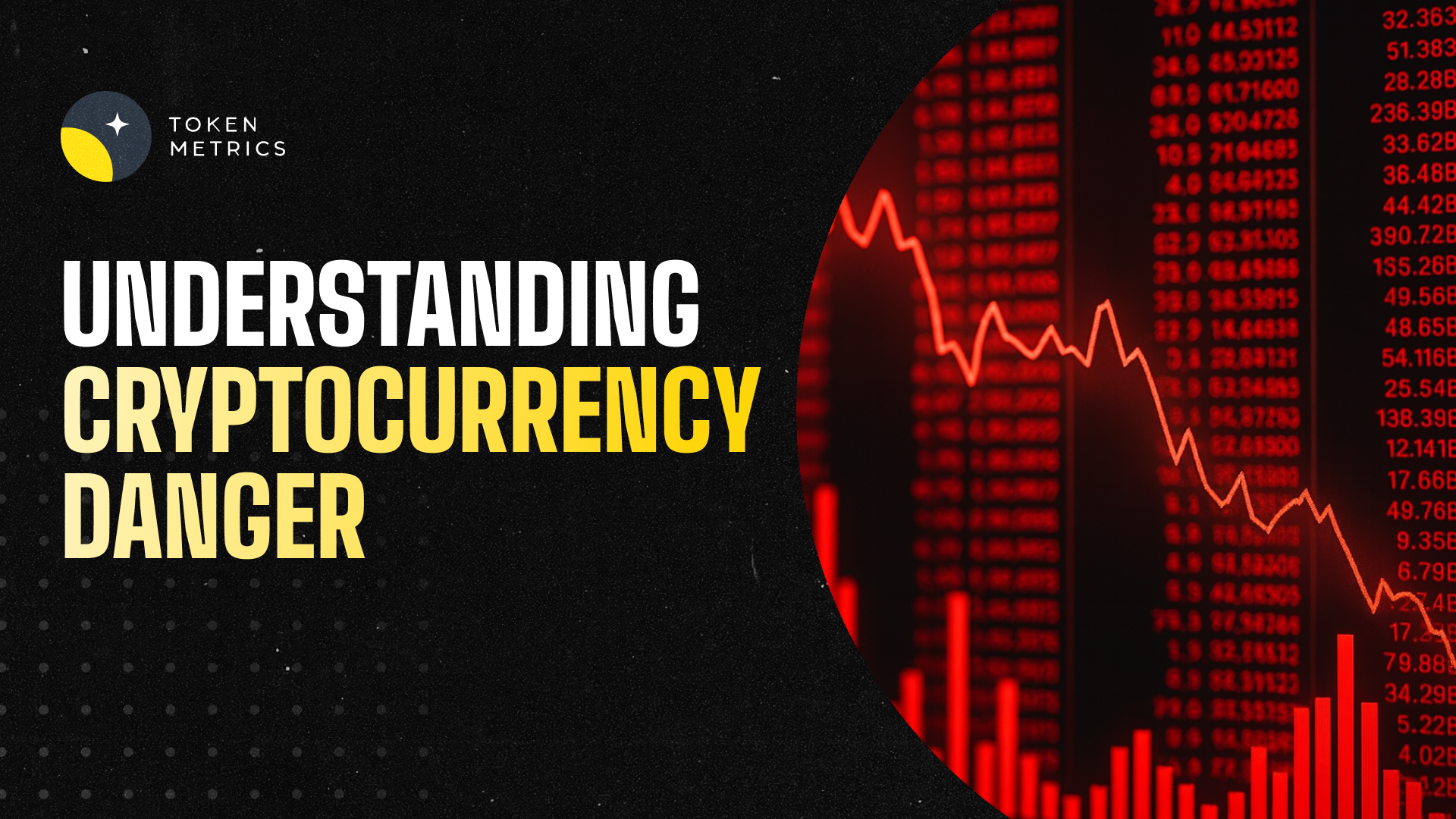
%201.svg)
%201.svg)
Cryptocurrency is a form of digital currency secured by cryptography, making it nearly impossible to counterfeit or double-spend. As a type of crypto asset, cryptocurrencies operate on decentralized networks powered by blockchain technology—a distributed public ledger maintained by multiple computers worldwide. This decentralized nature sets cryptocurrencies apart from traditional finance systems, which rely heavily on centralized financial institutions and central banks.
Most cryptocurrencies are not issued or regulated by any central authority, which makes them resistant to government interference or manipulation. While this independence offers certain freedoms, it also means that cryptocurrency investments carry substantial risk. The underlying cryptography and blockchain technology are generally secure, but their complexity can be challenging for new users to navigate. Additionally, the market value of cryptocurrencies is often affected by media hype and investor opinion, further contributing to their volatility. Understanding cryptocurrency danger involves exploring both the innovative technology behind it and the volatile market dynamics that influence its value.

Cryptocurrency exchanges play a crucial role as crypto asset service providers, allowing investors to buy and sell cryptocurrencies like Bitcoin and other cryptocurrencies at market prices. These exchanges function similarly to stock markets but operate 24/7, reflecting the highly volatile nature of the crypto market. However, many cryptocurrency exchanges lack a high level of governmental oversight or auditability compared to traditional banks, which can expose users to additional risks.
Once purchased, cryptocurrencies must be stored securely, either in digital wallets controlled by the user or through third-party services such as Coinbase, which assist with storing crypto assets safely. Some brokerage platforms, like Robinhood, provide access to cryptocurrency investments but may impose restrictions on withdrawals, limiting how investors can transfer or sell cryptocurrencies. This highlights the importance of understanding the terms and risks associated with each platform.
For those seeking exposure to the crypto asset class without directly holding digital wallets, crypto ETFs offer a more traditional investment vehicle. These funds track the market value of cryptocurrencies and can be bought and sold through conventional brokerage accounts, bridging the gap between digital assets and traditional finance.
One of the most significant cryptocurrency dangers lies in cybersecurity risks. Despite the security of blockchain technology, crypto investments are vulnerable to scams, hacks, software bugs, and the highly volatile price swings inherent in the market. The private key—a unique cryptographic code—is the sole access point to an investor’s digital wallet and cryptocurrency holdings. Losing this private key means losing access to the entire investment permanently, with no recourse. If a private key is stolen, there is no way to retrieve it, similar to having a credit card with no authentication check.
Technical challenges and market speculation add layers of risk that investors must carefully consider. Hackers frequently target digital wallets and cryptocurrency exchanges, attempting to steal digital assets. Numerous exchanges have suffered massive security breaches, leading to substantial losses for users. To mitigate these risks, many investors use offline hardware wallets or cold storage solutions, which keep private keys disconnected from the internet connection and significantly reduce the chances of theft.
Cryptocurrency investments are highly speculative and carry substantial risk, making them unsuitable for risk-averse investors. The market’s high price volatility can lead to rapid gains but also significant losses, and investors should only commit funds they can afford to lose. Cryptocurrencies can potentially yield high returns, attracting speculative investors. Unlike traditional finance, where financial institutions and regulatory bodies provide certain protections, cryptocurrency markets operate with limited oversight, increasing the potential for market manipulation and fraud.

Understanding one’s personal risk tolerance is crucial before deciding to invest in cryptocurrencies. The lack of regulatory control means that how funds are used or managed may be opaque, and the risk of losing money is real and significant. Investors should approach cryptocurrency investments with caution and seek advice from qualified investment advisors to navigate these complexities.
Despite the risks, cryptocurrencies offer unique advantages. By removing reliance on centralized intermediaries such as banks or credit card companies, cryptocurrencies reduce systemic financial risks and enable more direct, peer-to-peer transactions. Transfers between parties are secured through public and private key cryptography and validated by consensus mechanisms like proof of work or proof of stake, which underpin blockchain technology.
Crypto transfers can often be faster than traditional money transfers, especially in cross-border remittances where converting fiat currency typically involves multiple intermediaries. Decentralized finance innovations like flash loans demonstrate how cryptocurrency transactions can occur almost instantaneously, providing new opportunities for investment and trading.

However, cryptocurrencies also pose significant risks and challenges. While transactions are pseudonymous, digital trails remain traceable by law enforcement agencies such as the Federal Bureau of Investigation (FBI). Cryptocurrencies have been exploited for illicit activities including money laundering, dark web transactions, and ransomware payments. China has banned cryptocurrency exchanges, transactions, and mining, although it has developed a Central Bank Digital Currency (CBDC).
The concentration of wealth in the crypto space is increasing, with large companies and investment funds accumulating substantial holdings. Additionally, cryptocurrency mining demands significant energy consumption, often concentrating mining power among a few large firms with vast resources.
Off-chain security issues, such as vulnerabilities in third-party platforms, and the inherent price volatility continue to challenge the practical implementation of cryptocurrencies. The ideal of a fully decentralized system is often compromised by market manipulation and fraud, underscoring the cryptocurrency danger investors face.
Unlike fiat currency, which is government-issued legal tender, cryptocurrencies lack official issuance and their legal status varies widely across jurisdictions. In the United States, the Internal Revenue Service (IRS) treats cryptocurrencies as financial assets or property for tax purposes, requiring capital gains taxes on sales or trades.
U.S. courts have classified cryptocurrencies as securities for institutional buyers but not for retail investors trading on exchanges, reflecting the complex regulatory environment. In July 2023, U.S. courts ruled that cryptocurrencies are considered securities when purchased by institutional buyers but not by retail investors on exchanges. Similarly, cryptocurrency regulations in Asia differ significantly by country, demonstrating the global uncertainty surrounding digital assets.
Investors must stay informed about evolving legal frameworks to understand the implications of investing in cryptocurrencies and ensure compliance with tax and regulatory requirements.
The irreversible nature of cryptocurrency transactions and limited regulatory oversight make the space ripe for scams. Fraudsters often use fake endorsements, pressure tactics, and misleading schemes to steal money from unsuspecting investors. For example, some have lost substantial sums—like Rhett, who lost $97,000 to a fraudulent Bitcoin trading scheme.
To avoid falling victim to scams, investors should exercise caution, conduct thorough research, and verify the legitimacy of any investment opportunity. Consulting with reputable investment advisors and relying on trusted sources can help mitigate the risk of fraud and ensure safer participation in the crypto market.
Despite the inherent risks, many individuals are drawn to cryptocurrency for its potential gains and innovative technology. To protect digital currency assets, users must adopt proactive security measures. Understanding cybersecurity risks is essential to safeguarding crypto investments from hackers and bad actors.
Best practices include using hardware wallets like Ledger or Trezor, which provide enhanced security by keeping private keys offline. Investors should create duplicate hardware wallets and store backups in secure locations to prevent permanent loss of access. Staying vigilant against phishing attacks and avoiding sharing private keys or sensitive information is critical for maintaining control over digital assets.

Cryptocurrencies remain a highly speculative and risky asset class characterized by substantial price volatility and cybersecurity dangers. Investment advisors often recommend treating crypto investments as trading instruments rather than long-term holdings due to their unpredictable nature.
Cryptocurrency products carry risks including illiquidity and the potential for total loss of the entire investment. Investors should only allocate funds they can afford to lose and fully understand the technical complexities and market dynamics before engaging in cryptocurrency trading.
By staying informed, exercising caution, and following best security practices, investors can navigate the cryptocurrency landscape more safely. However, the cryptocurrency danger remains real, and careful consideration is essential before investing in this rapidly evolving digital asset space. Understanding the security and risks related to cryptocurrency requires a much higher level of engagement than traditional investments.


 Create Your Free Account
Create Your Free Account9450 SW Gemini Dr
PMB 59348
Beaverton, Oregon 97008-7105 US
.svg)




.png)
Token Metrics Media LLC is a regular publication of information, analysis, and commentary focused especially on blockchain technology and business, cryptocurrency, blockchain-based tokens, market trends, and trading strategies.
Token Metrics Media LLC does not provide individually tailored investment advice and does not take a subscriber’s or anyone’s personal circumstances into consideration when discussing investments; nor is Token Metrics Advisers LLC registered as an investment adviser or broker-dealer in any jurisdiction.
Information contained herein is not an offer or solicitation to buy, hold, or sell any security. The Token Metrics team has advised and invested in many blockchain companies. A complete list of their advisory roles and current holdings can be viewed here: https://tokenmetrics.com/disclosures.html/
Token Metrics Media LLC relies on information from various sources believed to be reliable, including clients and third parties, but cannot guarantee the accuracy and completeness of that information. Additionally, Token Metrics Media LLC does not provide tax advice, and investors are encouraged to consult with their personal tax advisors.
All investing involves risk, including the possible loss of money you invest, and past performance does not guarantee future performance. Ratings and price predictions are provided for informational and illustrative purposes, and may not reflect actual future performance.



